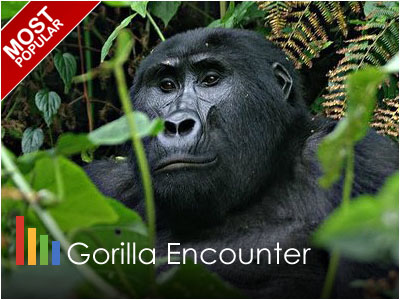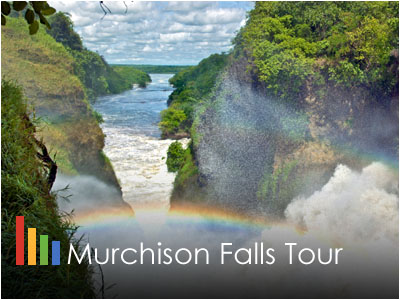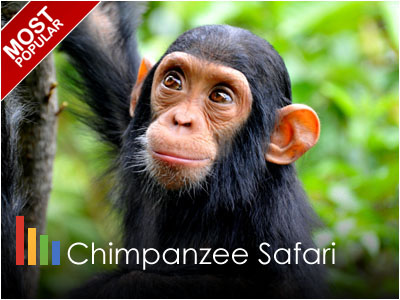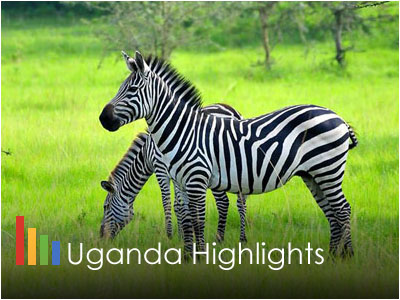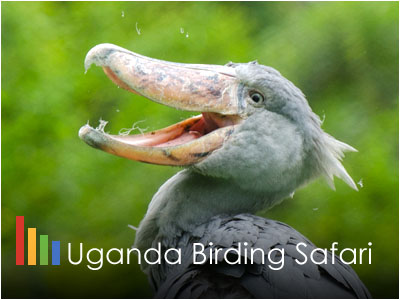Kibale Forest National Park, Uganda, Africa
Kibale Forest National Park - Uganda, Africa
Kibale National Park is the best place in Uganda to spend a morning or even a full day with the chimpanzees. It lies in one of the loveliest and most varied pieces of tropical forest in Uganda. Kibale National Park is one of the very few remaining places in the world where wild chimps flourish. A beautiful lanscape of tropical forest and crater lakes plays home to a number of habituated chimp families. Spending time with these uniquely human primates is one of the most interactive and incredible safari experiences possible. Forest cover, interspersed with patches of grassland and marsh, dominates the northern and central parts of the park on an elevated plateau. Like the rest of Uganda, Kibale has magnificent bird life – over 375 species. It's also home to some 70 species of mammals, including 13 species of primates.
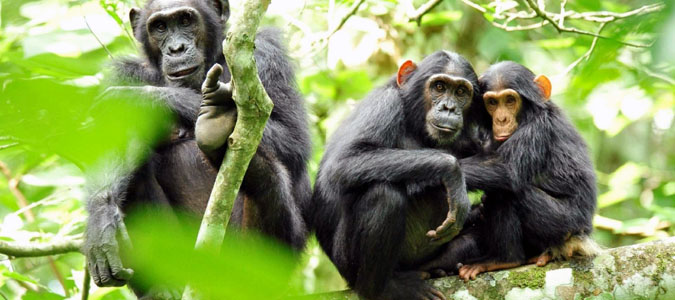
Basic Facts - Kibale Forest National Park
Kibale covers an area of approximately 775 sq km and is highest at the park’s northern tip, which stands 1,590m above sea level. The lowest point is 1,100m on the floor of the Albertine Rift Valley to the south. 351 tree species have been recorded in the park, some rise to over 55m and are over 200 years old. Kibale’s varied altitude supports different types of habitat, ranging from wet tropical forest on the Fort Portal plateau to woodland and savanna on the rift valley floor. Kibale is one of Africa’s foremost research sites. While many researchers focus on the chimpanzees and other primates found in the park, others are investigating Kibale’s ecosystems, wild pigs and fish species, among other topics. Kibale National Park offers one of the best chimpanzee viewing opportunities in the world. Visitors to this green and verdant park can expect to see, hear, and even smell our closest living relatives in close proximity as they race through the trees overhead. A large expanse of pristine forest and close to wetlands, Kibale is also home to an additional six primate species, forest elephants, and a huge variety of bird life. In fact, more than 370 species call the park’s trees and wetlands home.
More About Kibale Forest National Park
Kibale National Park is Located in Western Uganda, protecting moist evergreen rain forest. It is 766 square kilometres (296 sq mi) in size and is located between 1,100 metres (3,600 ft) to 1,600 metres (5,200 ft) in elevation. Despite encompassing primarily moist evergreen forest, it contains a diverse array of landscapes. Kibale National Park is one of the last remaining expanses to contain both lowland and montane forests. In eastern Africa, it sustains the last significant expanse of pre-montane forest. The park was gazetted in 1932 and formally established in 1993 to protect a large area of forest previously managed as a logged forest reserve. The park forms a continuous forest with Queen Elizabeth National Park. This adjoining of the parks creates a 180 kilometres (110 mi) wildlife corridor. It is an important eco-tourism and safari destination, popular for its population of habituated chimpanzees and twelve other species of primates. Two major tribes, the Batooro and Bakiga, inhabit the area around the park. They use the park for food, fuel, and other resources with the help of the Uganda Wildlife Authority.
In the last century, the population around the park has increased by sevenfold. This is speculated to be because the park directly brings in revenue for those living around it and the tourism industry creates jobs. In addition, many farmers believe that the soil is better for growing crops year round. This increase in the population has caused the area around the park to be divided and developed or turned into plantations and farmland, and demand for firewood asserts pressure on the park's wildlife habitat. Organizations like the New Nature Foundation are working to restore harmony to the people-park relationship by empowering local citizens to meet their needs in sustainable ways..
Kibale National Park contains one of the loveliest and most varied tracts of tropical forest in Uganda. Forest cover, interspersed with patches of grassland and swamp, dominates the northern and central parts of the park on an elevated plateau. Kibale is famously known for Chimpanzee tracking. The park is home to a total of 70 mammal species, most famously 13 species of primate including the chimpanzee. It also contains over 375 species of birds. Kibale adjoins Queen Elizabeth National Park to the south to create a 180km-long corridor for wildlife between Ishasha, the remote southern sector of Queen Elizabeth National Park, and Sebitoli in the north of Kibale National Park. The Kibale-Fort Portal area is one of Uganda’s most rewarding destinations to explore. The park lies close to the tranquil Ndali-Kasenda crater area and within half a day’s drive of the Queen Elizabeth, Rwenzori Mountains and Semuliki National Parks, as well as the Toro-Semliki Wildlife Reserve. For more information regarding this topic, DO NOT hesitate to Contact Us.
Kibale National Park is most famous for its chimpanzees, which can be seen here in huge numbers. Uganda's largest chimpanzee population, numbering 1,450 individuals, lives within the shady groves of this beautiful forest, along with 12 other primate species including red colobus monkeys and the rare I'Hoest's Monkey. Chimpanzee trekking and habituation are popular activities within the park. Most famous for its primate population, Kibale is actually home to 70 species of mammal including elephants, leopards, and warthogs. There are also almost 400 species of bird and more than 200 species of butterfly. The park is also home to the Bigodi Wetland Sanctuary and Kihingami Wetland, offering visitors the opportunity to experience a very different biosphere alive with animals not seen on conventional safaris.
AfriChoice operates a wide range of carefully designed tours and safaris to Kibale Forest National Park by providing transport and booking a hotel for you. Our safari consultants will always be at your assistance should you need a tailor-made holiday to this unique destination. NB: For more information regarding Kibale Forest National Park, DO NOT hesitate to Contact Us.
Contact Us for more information:
Uganda Popular Wildlife Safaris
-
Gorilla Tracking Safari
Bwindi Gorilla Safari 3 Days
-
Murchison Falls Safari
Murchison Falls Safari Tour
-
Uganda Chimpanzee Safari
Uganda Chimpanzee Watching Safari
-
Uganda Highlights Safari
Uganda Birds, Gorillas & Big Game Safari
-
Jane Goodall Safari Trail
Jane Goodall Chimpanzee Safari
-
Best of Uganda Safari
Uganda Wildlife & Adventure Tour
-
Uganda Birding Safari
Uganda Wildlife & Bird-watching Tour
-
Uganda Photography Safari
Uganda Gorilla & Wildlife Safari



 Paul Kitching - UK
Paul Kitching - UK Karen Howard - CANADA
Karen Howard - CANADA


